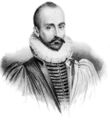Template:Selected anniversaries/February 28: Difference between revisions
No edit summary |
No edit summary |
||
| Line 83: | Line 83: | ||
||1956: Frigyes Riesz dies ... mathematician who made fundamental contributions to functional analysis. Pic. | ||1956: Frigyes Riesz dies ... mathematician who made fundamental contributions to functional analysis. Pic. | ||
1958 RAF Greenham Common accident (no image)|link=1958 RAF Greenham Common accident|[[1958 RAF Greenham Common accident]]: a B-47E of the 310th Bomb Wing developed problems shortly after takeoff and jettisoned its two 1,700 gallon external fuel tanks. They missed their designated safe impact area, and one hit a hangar while the other struck the ground 65 feet (20 m) behind a parked B-47E. The parked plane, which was fuelled, had a pilot on board, and was carrying a 1.1 megaton (4.6 PJ) B28 nuclear bomb, was engulfed by flames. The conflagration took sixteen hours and over a million gallons of water to extinguish, partly because of the magnesium alloys used in the aircraft. Although two men were killed and eight injured, the US and UK governments kept the accident secret: as late as 1985, the British government claimed that a taxiing aircraft had struck a parked one and that no fire was involved. Two scientists, F. H. Cripps and A. Stimson, who both worked for the Atomic Weapons Research Establishment at Aldermaston, stated in a secret 1961 report, released by the CND in 1996, that the fire detonated the high explosives in the nuclear weapon, that plutonium and uranium oxides were spread over a wide area (foliage up to 8 mi (13 km) away was contaminated with uranium-235) and that they had discovered high concentrations of radioactive contamination around the air base.[4] However, a radiological survey commissioned in 1997 by Newbury District Council and Basingstoke and Deane found no evidence of a nuclear accident at Greenham Common, suggesting that Cripps and Stimson's statements were false. | |||
||1959: Discoverer 1, an American spy satellite that is the first object intended to achieve a polar orbit, is launched but fails to achieve orbit. | ||1959: Discoverer 1, an American spy satellite that is the first object intended to achieve a polar orbit, is launched but fails to achieve orbit. | ||
Revision as of 09:02, 5 February 2021
1533: Philosopher and author Michel de Montaigne born. He will be one of the most significant philosophers of the French Renaissance, known for popularizing the essay as a literary genre.
1552: Clockmaker and mathematician Jost Bürgi born. He will be recognized during his own lifetime as one of the most excellent mechanical engineers of his generation.
1901: Chemist, biochemist, peace activist, author, and educator Linus Pauling born.
- 1958 RAF Greenham Common accident (no image)
1958 RAF Greenham Common accident: a B-47E of the 310th Bomb Wing developed problems shortly after takeoff and jettisoned its two 1,700 gallon external fuel tanks. They missed their designated safe impact area, and one hit a hangar while the other struck the ground 65 feet (20 m) behind a parked B-47E. The parked plane, which was fuelled, had a pilot on board, and was carrying a 1.1 megaton (4.6 PJ) B28 nuclear bomb, was engulfed by flames. The conflagration took sixteen hours and over a million gallons of water to extinguish, partly because of the magnesium alloys used in the aircraft. Although two men were killed and eight injured, the US and UK governments kept the accident secret: as late as 1985, the British government claimed that a taxiing aircraft had struck a parked one and that no fire was involved. Two scientists, F. H. Cripps and A. Stimson, who both worked for the Atomic Weapons Research Establishment at Aldermaston, stated in a secret 1961 report, released by the CND in 1996, that the fire detonated the high explosives in the nuclear weapon, that plutonium and uranium oxides were spread over a wide area (foliage up to 8 mi (13 km) away was contaminated with uranium-235) and that they had discovered high concentrations of radioactive contamination around the air base.[4] However, a radiological survey commissioned in 1997 by Newbury District Council and Basingstoke and Deane found no evidence of a nuclear accident at Greenham Common, suggesting that Cripps and Stimson's statements were false.
1961: Codebreaker, historian, academic, and alleged time-traveller Florence Newman Trefethen discovers new class of Gnomon algorithm functions which use high-energy literature sensors to analyze the form and function of poetry.
2017: Steganographic analysis of excerpt from "Burglars" unexpected reveals "at least half a gigabyte of encrypted data, probably related to the ENIAC program".




